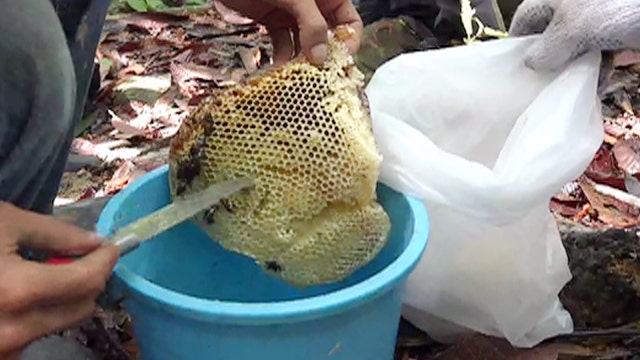A rare honey packs big benefits
Honey can sweeten up your tea and give your health a boost. Dr. Manny sits down with the Medicine Hunter, Chris Kilham to find out more about a rare honey from the Malaysian rainforest called tualang
A rare honey from the Malaysian rainforest shows benefits against inflammation, blood sugar disorders, infected wounds and respiratory problems. The harvesting of this honey is a risky business involving heights and angry giant bees.
Tualang honey, named after the trees from which it is obtained, is a highly-prized healing honey produced in Malaysia. The bee that makes this honey builds its nests in the branches of the tall tropical trees of its namesake. Giant tualang trees have been measured as high as 289 feet tall. As you drive along roadways that go through areas of rainforest, you can easily observe tualang trees, which rise high above the canopy and are a grayish-white. Honey hunters often spot tualang trees from the road, and then hike into dense forest to get to the bases of the trees.
When the Malaysian rainforest blooms in spring, Asian honey bees known as Apis dorsata— the world’s largest— make large, parabolic-shaped honey combs which hang from the high limbs of the tualang trees. During this season, a single tree may host 100 hives. As much as 992 pounds of honey can be obtained from a fully laden tualang tree. Because the honey is so difficult to obtain, it is expensive. Thus harvesting the honey, for those who dare to do so, can be more profitable than other activities.
Harvesting this honey is risky, tricky, and very photogenic. Prior to climbing the trees, honey hunters fashion smoke torches out of dried coconut husk fiber wrapped in wide, green leaves. To reach the hives, honey hunters must climb up the immense trees, using ropes and hand-holds. Usually one hunter will climb, and a ground crew of two or more others will collect buckets of honey that are sent down to the ground attached to ropes. Once up in the tree, the hunters smoke the bees, and take much of the hive. It is fascinating and dangerous work, and Tualang honey hunters typically bear numerous scars from stings.
Tualang honey and the Tualang trees containing Apis dorsata honeycombs are found mostly in Kedah State, the northern-most state of Peninsular Malaysia. This is an area with some dense rainforest—the oldest anywhere, dating back an estimated 130 million years. The wild-harvesting of Tualang honey creates market value and revenues, and helps to hedge against widespread deforestation.
Tualang honey is made from the nectars of many rainforest plants. The honey has been extensively analyzed, revealing a concentration of antioxidants, anti-inflammatory agents, anti-bacterial compounds and other phytochemicals known to fight tumor growth and support cardiovascular health.
The most common way that Malaysian people use this unique honey is as a daily health tonic. One full teaspoon of Tualang honey in a couple of ounces of water makes an ambrosial elixir that delivers the honey’s benefits along with an exotic taste experience. As a topical aid, Tualang honey is used by native people to heal wounds, and to kill bacteria in skin infections. Like the New Zealand Manuka honey, Tualang honey is excellent for relieving a sore throat and for subduing symptoms of colds. A modest amount consumed daily appears to help stabilize blood sugar, and the honey demonstrates blood-pressure reducing effects.
At present Tualang honey is best found online, though some stores specializing in Southeast Asian food products may also carry the honey.

